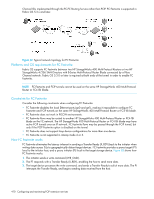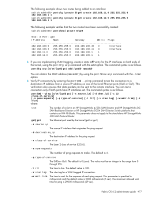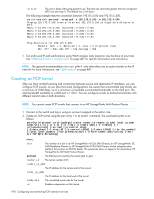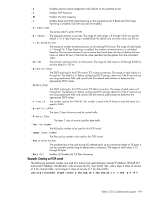HP StorageWorks 8/80 HP StorageWorks Fabric OS 6.2 administrator guide (5697-0 - Page 478
FCIP services configuration guidelines
 |
View all HP StorageWorks 8/80 manuals
Add to My Manuals
Save this manual to your list of manuals |
Page 478 highlights
Example: Disabling FC Fastwrite on a switch switch:admin> fastwritecfg --disable 7 !!!! WARNING !!!! Disabling FC Fastwrite will require powering off and back on the and it may take up to 5 minutes. For non bladed system, the switch will be rebooted. Data traffic will be disrupted. Continue (Y,y,N,n): [ n] y Slot 7 is being powered off Disabling FC Fastwrite on a port 1. Connect to the switch and log in using an account assigned to the admin role. 2. Enter the following command: switch:admin> portcfg fastwrite [slot/]port --disable where slot is the slot in which the B-Series Multi-Protocol Router Blade is installed, and port is the port number. A slot number is not required for the BHP StorageWorks 400 Multi-Protocol Router. FCIP services configuration guidelines There are multiple configuration requirements and options associated with FCIP services. The following general guidelines may be helpful. The steps are presented in an order that minimizes the number of times ports need to be disabled and enabled. In practice, the steps do not have to be taken in this order. 1. Determine if you are implementing IPsec. IPsec configuration may be done at any time, but defining IPsec policies first ensures that they will be available when FCIP tunnels are configured. See "IPsec configuration" on page 461 for specific instructions. 2. Determine which FCIP tunnel you want to configure. Each FCIP tunnel is associated with a specific virtual port, and a specific Ethernet port, as shown in Table 90 on page 457. For example, if you want to configure FCIP tunnel 0, you need to configure virtual port 16, and define an IP interface and one or more IP routes over ge0. 3. Persistently disable the virtual ports before you configure them. Ports on a new HP StorageWorks 400 Multi-Protocol Router or B-Series Multi-Protocol Router Blade are persistently disabled by default. On an HP StorageWorks 400 Multi-Protocol Router or FC4-18i blade that has already been installed and configured, check the EX_Port status using the portCfgShow command, and persistently disable the ports using the portCfgPersistentDisable command before you configure them. See "Setting persistently disabled ports" on page 475 for a description. 4. The Ethernet port associated with the tunnel should also be disabled. Before disabling an Ethernet port, be sure there are no other tunnels active on the port. If there are, disabling the port will disable the tunnel or tunnels. 5. Determine if any of the virtual ports should be VEX_Ports, and configure them using the portCfgVEXPort command. See "Configuring VEX_Ports" on page 475 for specific instructions. 6. Create an IP interface using the portCfg ipif command. See "Creating IP interfaces and routes" on page 476 for specific instructions. 7. Create one or more IP routes using the portCfg iproute command. See "Creating IP interfaces and routes" on page 476 for specific instructions. 8. If you are implementing VLAN tagging, create a static ARP entry for the IP interface using the portCfg arp command. See "Creating IP interfaces and routes" on page 476 for specific instructions. 9. Test the IP connection using the portCmd --ping command. See "Creating IP interfaces and routes" on page 476 for specific instructions. 10. Create an FCIP tunnel using the portCfg fciptunnel command. See "Creating an FCIP tunnel" on page 478 for specific instructions. 474 Configuring and monitoring FCIP extension services















